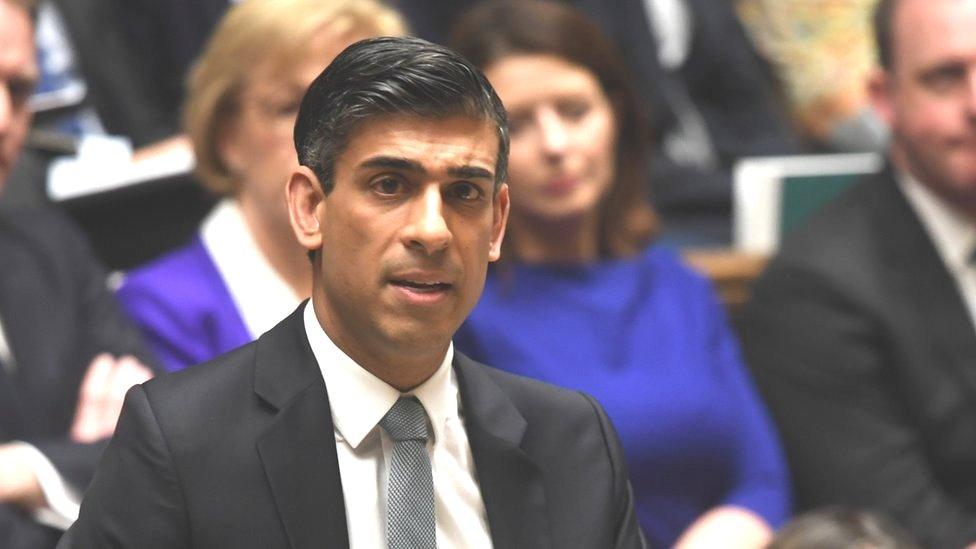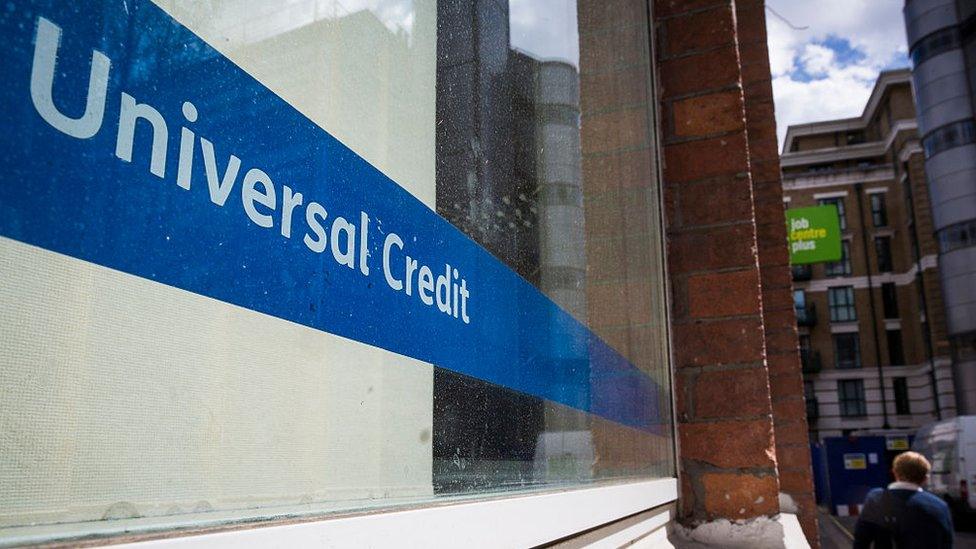Q&A: how does the Spring Statement affect Scots?
- Published

Not all the measures in the chancellor's Spring Statement affect Scots directly, mainly because Holyrood has control of most income tax rates thresholds and rates.
But there are significant challenges facing the Scottish government.

How do the tax and national insurance changes affect Scots?
National Insurance is controlled at Westminster, while income tax rates and thresholds are for Scottish ministers to decide.
So the increase in the rate of both employers' and employees' National Insurance Contributions (NICs) affects every part of the UK.
On payroll earnings, the NIC rate is going up next month from 12% to 13.25%. Employers face a similar rise in their contribution.
The Spring Statement eased the impact of that increase by raising the threshold at which people start to pay NICs - from £9,570 to £12,570.
That means a flat-rate giveaway to everyone paying NICs of £352. It doesn't affect employer contributions.
That change brings NICs into line with the starting point of income tax, for all UK income tax payers. The starting threshold is one income tax power retained at Westminster for all of the UK.

The chancellor laid out his Spring Statement on Wednesday
Rishi Sunak stated his intention to cut the basic rate of income tax at Westminster in 2024, just ahead of an expected election.
If he delivers on that, the basic rate would come down from 20p in the pound to 19p. That would not affect tax paid on Scottish income - not directly, anyway, and it would affect tax paid on Scottish savings interest.
What effect will the Treasury's decisions have on the block grant that it hands to Holyrood?
That block grant provides most of the funds that Holyrood ministers spend, to which revenue is added in Scotland from income tax, business rates and Land and Buildings Transactions Tax.
Changes to it are determined by changes to funding for the big "spending departments" in Whitehall such as health, education, justice and transport.
These gained in funding in Rishi Sunak's Budget for next year, set out last year, but they do not take account of inflation. So spending departments will have to absorb the extra costs they face in the coming year, notably public sector pay.
And that constraint is passed on through the block grant to Holyrood.
Public sector pay is already rising more slowly than private sector pay, and that is expected to continue. In real terms (after inflation), it is expected to fall significantly, raising the potential for pay disputes between employers and unions.
That is one of the challenges the Scottish government and local authorities will face, unless further funding is released later this year to take account of public sector pay deals.
How can the Scottish government respond?
Scottish ministers have powers over welfare benefits which could allow them to mitigate, if only partly, the impact of inflation on those with the tightest budgets.
Holyrood is already spending some of its funds to offset the impact of UK welfare decisions that are seen by MSPs as unfair. The funds to continue doing so are not unlimited.

The chancellor's decision to announce a cut in the basic rate of income tax is a strange one, long before he knows how public finances will look, and appears to reverse the impact of a rise in NICs this year, which he says is necessary to pay for health and social care.
While that will not apply in Scotland, it should mean that more funds are added to the Holyrood block grant - probably around £500m to £600m.
Scottish ministers could then decide to use that to cut income tax, or to use it for extra spending.
The decision is likely to be highly political, as is Rishi Sunak's tax cut.
When most of income tax was devolved to Holyrood, from 2018, the SNP administration chose to make a cut to the lowest rate, worth £20 per year and allowing it to say Scotland has the lowest rate of tax in Britain, but there were bigger increases to tax on higher earners.
With two extra bands of tax introduced, making it a five-band system, the main rates applied are one penny in the pound higher.
And while Westminster raised the threshold at which higher rate tax payers start to pay 40p on each extra pound earned, to more than £50,000, that threshold was kept lower in Scotland. It is being frozen in 2022-23 at £43,662.
That should bring in more funds, but there is evidence from the Scottish Fiscal Commission that the tax base is weaker than previously thought, and that the block grant from Westminster would actually be higher if the powers had not been devolved.
So three questions for Scottish ministers:
How much does it matter politically that tax rates in Scotland are compared with those in other parts of the UK, as the systems diverge?
How much could that divergence result in lower revenue?
Do they want to use their tax powers to raise funds for more generous public services?
As Rishi Sunak's intended tax cut is still two years away, there is no rush to answer these.
The chancellor is gaining tax revenue by freezing income tax thresholds. How does that affect Scots?
Over time, earnings usually rise and people move up the career ladder. As they do so, they move into higher tax brackets, paying higher income tax rates.
Rishi Sunak last year said he would freeze the thresholds for higher rate tax, as well as the starter threshold of £12,570, which applies across the UK. That can a be a stealthy way of raising tax revenue.
But with high inflation and more people moving into the higher brackets, it is much less stealthy and much more of a tax grab. By the next Westminster election, the impact of that is expected to be worth £17bn a year.
That is one of the main reasons why the public finances in the spring statement are looking relatively strong.
The Scottish government has frozen those thresholds for longer. It hasn't said it will keep them frozen, as Mr Sunak has said, but the Holyrood administration is doing so on higher rate tax into 2022-23.
Why put up NICs while cutting income tax?
This is one of the mysteries of Rishi Sunak's spring statement. He said higher NICs were required to pay for health and social care, at least in England, with a share of revenue being added to the Holyrood block grant. Yet having said the revenue is essential, he then took two contradictory decisions:
to reduce the revenue by raising the threshold for NICs, yet doing nothing (for obvious political reasons) to cut back on the amount going to health and social care.
he set out to cut Westminster's basic rate of income tax, at a time when it's likely far more will be required to pay for health and social care.
So it's a muddled picture: raising NICs rates, and the threshold, while lowering income tax and freezing thresholds.
One effect of this is to raise tax on working people, while a cut in income tax helps those whose income comes from wealth, such as dividends and rents.
What support is there for Scots on lower income?
The chancellor chose not to raise the percentage increase in benefits or pensions, to take account of higher inflation than last September, which is the month on which uprating is set.

So benefits rise 3.1%, while prices are forecast to rise on average 7.4%.
When challenged on this, the chancellor points to a number of initiatives to help people getting into work and on low wages, including a 6.6% rise in living wage later this year and a more generous tapering away of Universal Credit as people pick up hours of work.
He offered a rise in a safety net fund, from £500m to £1bn, handed to local authorities to distribute to those in most need. Of that rise, £45m is being added to the Scottish block grant, for Scottish ministers to spend as they choose.
The Scottish government is aiming much of its new welfare budget at families, with a new payment for young children rising from £10 to £25 per week later this year.
Related topics
- Published24 March 2022

- Published23 March 2022

- Published23 March 2022
